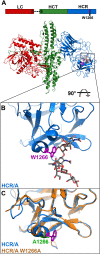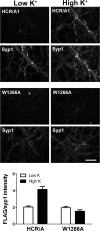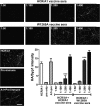Enhancing the protective immune response against botulism
- PMID: 23670557
- PMCID: PMC3697623
- DOI: 10.1128/IAI.00382-13
Enhancing the protective immune response against botulism
Abstract
The need for a vaccine against botulism has increased since the discontinuation of the pentavalent (ABCDE) botulinum toxoid vaccine by the Centers for Disease Control and Prevention. The botulinum toxins (BoNTs) are the primary virulence factors and vaccine components against botulism. BoNTs comprise three domains which are involved in catalysis (LC), translocation (HCT), and host receptor binding (HCR). Recombinant HCR subunits have been used to develop the next generation of BoNT vaccines. Using structural studies and the known entry properties of BoNT/A, an HCR subunit vaccine against BoNT/A that contained the point mutation W1266A within the ganglioside binding pocket was designed. HCR/A(W1266A) did not enter primary neurons, and the crystal structure of HCR/A(W1266A) was virtually identical to that of wild-type HCR/A. Using a mouse model, experiments were performed using a high-dose vaccine and a low-dose vaccine. At a high vaccine dose, HCR/A and HCR/A(W1266A) elicited a protective immune response to BoNT/A challenge. At the low-dose vaccination, HCR/A(W1266A) was a more protective vaccine than HCR/A. α-HCR IgG titers correlated with protection from BoNT challenge, although titers to block HCR/A entry were greater in serum in HCR/A-vaccinated mice than in HCR/A(W1266A)-vaccinated mice. This study shows that removal of receptor binding capacity enhances potency of the subunit HCR vaccine. Vaccines that lack receptor binding capacity have the added property of limited off-target toxicity.
Figures




Similar articles
-
Subunit vaccine efficacy against Botulinum neurotoxin subtypes.Vaccine. 2011 Oct 13;29(44):7688-95. doi: 10.1016/j.vaccine.2011.07.134. Epub 2011 Aug 10. Vaccine. 2011. PMID: 21839134 Free PMC article.
-
Enhancing toxin-based vaccines against botulism.Vaccine. 2018 Feb 1;36(6):827-832. doi: 10.1016/j.vaccine.2017.12.064. Epub 2018 Jan 4. Vaccine. 2018. PMID: 29307477 Free PMC article.
-
A mutated recombinant subunit vaccine protects mice and guinea pigs against botulinum type A intoxication.Hum Vaccin Immunother. 2018 Feb 1;14(2):329-336. doi: 10.1080/21645515.2017.1405201. Epub 2017 Dec 19. Hum Vaccin Immunother. 2018. PMID: 29140753 Free PMC article.
-
Vaccines against botulism.Curr Opin Microbiol. 2012 Jun;15(3):317-24. doi: 10.1016/j.mib.2012.05.009. Epub 2012 Jun 12. Curr Opin Microbiol. 2012. PMID: 22694934 Review.
-
What next for botulism vaccine development?Expert Rev Vaccines. 2013 May;12(5):481-92. doi: 10.1586/erv.13.37. Expert Rev Vaccines. 2013. PMID: 23659297 Review.
Cited by
-
A Novel Botulinum Neurotoxin, Previously Reported as Serotype H, Has a Hybrid-Like Structure With Regions of Similarity to the Structures of Serotypes A and F and Is Neutralized With Serotype A Antitoxin.J Infect Dis. 2016 Feb 1;213(3):379-85. doi: 10.1093/infdis/jiv327. Epub 2015 Jun 10. J Infect Dis. 2016. PMID: 26068781 Free PMC article.
-
Formation and Maturation of the Phagosome: A Key Mechanism in Innate Immunity against Intracellular Bacterial Infection.Microorganisms. 2020 Aug 25;8(9):1298. doi: 10.3390/microorganisms8091298. Microorganisms. 2020. PMID: 32854338 Free PMC article. Review.
-
Entry of Botulinum Neurotoxin Subtypes A1 and A2 into Neurons.Infect Immun. 2016 Dec 29;85(1):e00795-16. doi: 10.1128/IAI.00795-16. Print 2017 Jan. Infect Immun. 2016. PMID: 27795365 Free PMC article.
-
High resolution crystal structures of the receptor-binding domain of Clostridium botulinum neurotoxin serotypes A and FA.PeerJ. 2018 Mar 21;6:e4552. doi: 10.7717/peerj.4552. eCollection 2018. PeerJ. 2018. PMID: 29576992 Free PMC article.
-
Potency Evaluations of Recombinant Botulinum Neurotoxin A1 Mutants Designed to Reduce Toxicity.Int J Mol Sci. 2024 Aug 17;25(16):8955. doi: 10.3390/ijms25168955. Int J Mol Sci. 2024. PMID: 39201641 Free PMC article.
References
-
- Torda C, Wolff HG. 1947. On the mechanism of paralysis resulting from toxin of Clostridium botulinum; the action of the toxin on acetylcholine synthesis and on striated muscle. J. Pharmacol. Exp. Ther. 89:320–324 - PubMed
-
- Davletov B, Bajohrs M, Binz T. 2005. Beyond BOTOX: advantages and limitations of individual botulinum neurotoxins. Trends Neurosci. 28:446–452 - PubMed
-
- Johnson EA. 1999. Clostridial toxins as therapeutic agents: benefits of nature's most toxic proteins. Annu. Rev. Microbiol. 53:551–575 - PubMed
-
- Evidente VG, Adler CH. 2010. An update on the neurologic applications of botulinum toxins. Curr. Neurol. Neurosci. Rep. 10:338–344 - PubMed
Publication types
MeSH terms
Substances
Grants and funding
LinkOut - more resources
Full Text Sources
Other Literature Sources
Medical

